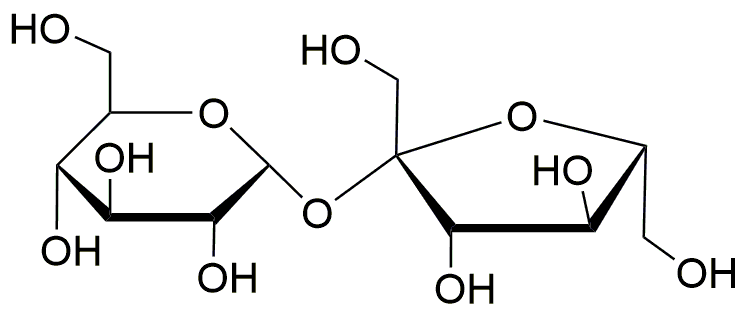Sucrose is widely utilized in research focused on:
- Food Industry: As a primary sweetener, sucrose enhances the flavor of various food products, including beverages, baked goods, and candies. Its ability to improve taste while providing energy makes it a staple in food formulation.
- Pharmaceuticals: In medicine, sucrose is often used as an excipient in drug formulations. It helps in masking the bitter taste of medications, making them more palatable for patients, especially children.
- Biotechnology: Sucrose serves as a carbon source in microbial fermentation processes. It supports the growth of microorganisms used in producing enzymes, biofuels, and other bioproducts, thus playing a crucial role in sustainable practices.
- Cosmetics: In the cosmetic industry, sucrose is used in scrubs and exfoliants due to its natural exfoliating properties. It helps to remove dead skin cells, leaving the skin smooth and rejuvenated.
- Research Applications: Sucrose is frequently employed in laboratory settings as a cryoprotectant for biological samples. It helps preserve cells and tissues during freezing, ensuring their viability for future studies.
Información general
Propiedades
Seguridad y normativas
Aplicaciones
Sucrose is widely utilized in research focused on:
- Food Industry: As a primary sweetener, sucrose enhances the flavor of various food products, including beverages, baked goods, and candies. Its ability to improve taste while providing energy makes it a staple in food formulation.
- Pharmaceuticals: In medicine, sucrose is often used as an excipient in drug formulations. It helps in masking the bitter taste of medications, making them more palatable for patients, especially children.
- Biotechnology: Sucrose serves as a carbon source in microbial fermentation processes. It supports the growth of microorganisms used in producing enzymes, biofuels, and other bioproducts, thus playing a crucial role in sustainable practices.
- Cosmetics: In the cosmetic industry, sucrose is used in scrubs and exfoliants due to its natural exfoliating properties. It helps to remove dead skin cells, leaving the skin smooth and rejuvenated.
- Research Applications: Sucrose is frequently employed in laboratory settings as a cryoprotectant for biological samples. It helps preserve cells and tissues during freezing, ensuring their viability for future studies.
Documentos
Hojas de datos de seguridad (HDS)
La SDS proporciona información de seguridad completa sobre la manipulación, el almacenamiento y la eliminación del producto.
Especificación del producto (PS)
La PS proporciona un desglose completo de las propiedades del producto, incluida la composición química, el estado físico, la pureza y los requisitos de almacenamiento. También detalla los rangos de calidad aceptables y las aplicaciones previstas del producto.
Certificados de análisis (COA)
Busque certificados de análisis (COA) ingresando el número de lote del producto. Los números de lote y de partida se pueden encontrar en la etiqueta de un producto después de las palabras "Lote" o "Lote".
Número de catálogo
Número de lote/lote
Certificados de origen (COO)
Este certificado de origen confirma el país en el que se fabricó el producto y también detalla los materiales y componentes utilizados en él y si se deriva de fuentes naturales, sintéticas u otras fuentes específicas. Este certificado puede ser necesario para cumplir con las normativas aduaneras, comerciales y regulatorias.
Número de catálogo
Número de lote/lote
Hojas de datos de seguridad (HDS)
La SDS proporciona información de seguridad completa sobre la manipulación, el almacenamiento y la eliminación del producto.
DownloadEspecificación del producto (PS)
La PS proporciona un desglose completo de las propiedades del producto, incluida la composición química, el estado físico, la pureza y los requisitos de almacenamiento. También detalla los rangos de calidad aceptables y las aplicaciones previstas del producto.
DownloadCertificados de análisis (COA)
Busque certificados de análisis (COA) ingresando el número de lote del producto. Los números de lote y de partida se pueden encontrar en la etiqueta de un producto después de las palabras "Lote" o "Lote".
Número de catálogo
Número de lote/lote
Certificados de origen (COO)
Este certificado de origen confirma el país en el que se fabricó el producto y también detalla los materiales y componentes utilizados en él y si se deriva de fuentes naturales, sintéticas u otras fuentes específicas. Este certificado puede ser necesario para cumplir con las normativas aduaneras, comerciales y regulatorias.

